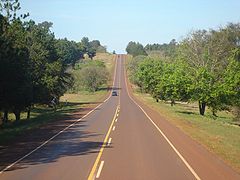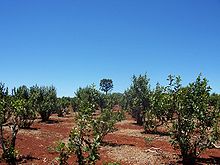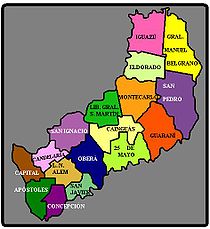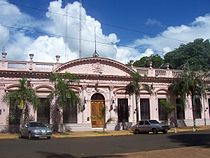- Misiones Province
-
Misiones — Province — Clockwise from top: Iguazú Falls (Iguazú National Park), Posadas, Guaraní Jesuit Mission of San Ignacio Miní, Yerba Mate plantation. 
Flag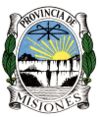
Coat of armsLocation of Misiones within Argentina Country Argentina Capital Posadas Departments 17 Municipalities 78 Government - Governor Maurice Closs - Deputies 7 - Senators 3 Area
Ranked 21st- Total 29.801 km2 (11.5 sq mi) Population (2010[1]) - Total 1.097.829 (Ranked 10th) - Density 36.8/km2 (95.3/sq mi) Demonym misionero Time zone ART (UTC−3) ISO 3166 code AR-N Website misiones.gov.ar Misiones (Spanish pronunciation: [miˈsjones], Missions) is one of the 23 provinces of Argentina, located in the northeastern corner of the country in the Mesopotamiсa region. It is surrounded by Paraguay to the northwest, Brazil to the north, east and south, and Corrientes Province of Argentina to the southwest.
Contents
History
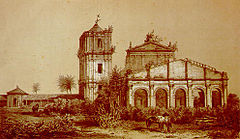 1846 impression of San Ignacio Miní, a Jesuit Reduction forcibly abandoned following the temporary abolition of the order in 1773.
1846 impression of San Ignacio Miní, a Jesuit Reduction forcibly abandoned following the temporary abolition of the order in 1773.
The province was originally populated by the Guarani culture. The first European to visit the region was Sebastian Cabot who, while navigating the Paraná River in December of 1527, found Apipé's falls. In 1541, Álvar Nuñez Cabeza de Vaca reached the Iguazú Falls.
In the 17th century, members of the Society of Jesus came to the zone. These missionaries began to build a string of Jesuit Reductions, that of San Ignacio being the most famous. In a few years, they managed to create 30 villages, wherein the Guarani, who had long been victims of the jungle and European slave-drivers alike, became skilled in agriculture and the arts, sharing in the Reductions' prosperity. In 1759, however, the Portuguese government, at the insistence of its anti-Jesuit chancellor, the Marquis de Pombal, ordered all Reductions in its territory (which then included much of today's Misiones Province) closed. The Marquis eventually prevailed on Pope Clement XIV to have the Jesuit Order suppressed in 1773. Once abandoned, the prosperous trade surrounding these Reductions quickly either vanished or degenerated into a brutal plantation economy, with the Guaranies its slaves.
In 1814, Gervasio Posadas, the director of United Provinces, declared Misiones annexed to Argentina's Corrientes (at this time Argentina was quasi-independent but nominally still Spanish territory). However, Argentina did not exert de facto control over Misiones, which was claimed by several countries and effectively governed itself, so in 1830 military forces from Corrientes Province took control of Misiones.
In 1838, Paraguay occupied Misiones, because Paraguay claimed Misiones on the basis that the Misiones population was indigenous Guarani, the major ethnic group of Paraguay. In 1865, Paraguayan forces invaded Misiones again, in what became the War of the Triple Alliance. Following the peace agreement with Argentina eventually signed in 1876, defeated Paraguay gave up its claim to the Misiones territory.
Although Argentina had claimed Misiones since 1814, academics tend to interpret Argentine possession of Misiones as a result of this war. Bethell's account is that "the treaty of alliance [i.e. against Paraguay] contained secret clauses providing for the annexation of disputed territory in northern Paraguay by Brazil and regions in the east and west of Paraguay by Argentina... After a long and harrowing war (1865-70), Argentina got it from a prostrate Paraguay territory in Misiones."[2] Scobie's analysis is that "the political status of Misiones remained vague" and that Argentina gained the region "as a by-product of the Paraguayan war in the 1860s".[3]
 Ukrainian immigrants harvest yerba mate in 1920. Despite its relative inhospitability, Misiones attracted considerable European immigration.
Ukrainian immigrants harvest yerba mate in 1920. Despite its relative inhospitability, Misiones attracted considerable European immigration.
After the War of the Triple Alliance, Paraguay was much impoverished, so Misiones benefited economically from belonging to Argentina. In 1876, President Nicolás Avellaneda, assisted by his close friend, General Pietro Canestro (an Italian nobleman who devoted much of his life and wealth to the achievement and sustainability of the peace in the region), proclaimed the Immigration and Colonization Law. This law would foster the immigration of European colonists in order to populate the vast unspoiled Argentinian territories.
To comply with this law, several colonizing companies were created. One of them was Adolf Schwelm's Eldorado Colonización y Explotación de Bosques Ltda. S.A., which founded the city of Eldorado in 1919 with a port on the Upper Paraná. Its agricultural colonies and experimental farms, the orange and grapefruit tree plantations and the cultivation of yerba mate, the mills and the dryers for such product are characteristic from this area. Swedish-Argentines became well known for growing yerba mate.
Misiones received many immigrants mostly from Europe coming mainly from Southern Brazil while some came from Buenos Aires, and from Eastern Europe, in particular large numbers of Polish and Ukrainian immigrants. Since then, Misiones has continued to benefit economically and has developed politically within Argentina. It has been successfully integrated into the Argentine state. Today, there is no controversy, either international or internal, surrounding ownership of the province. On December 10, 1953 the "National Territory of Misiones" gained provincial status by the Law 14.294, and its constitution was approved on April 21, 1958.
Misiones received more attention by national policy makers following an agreement providing for the construction of the Yacyretá hydroelectric dam on a point in the Paraná River shared by Paraguay and Corrientes Province. When the dam became fully operative, Paraná waters all along the Misiones shores rose and flooded lands that the dam's authorities failed to clean and condition adequately, resulting in onsets of mosquito-transmitted illnesses, such as leishmaniasis, yellow fever, dengue, and malaria. The entire Misiones shores along the Paraná River is now confined by two dams, one of them being Yaciretá downstream of the river and the other Itaipú, located in Brazil and Paraguay, upstream of the river and north of Puerto Iguazú. Currently, an agreement is being pursued with Paraguay which would allow reservoir expansion works that could double the facility's electric production.
Geography
Misiones is the second smallest province after Tucumán.
The Misiones plateau includes a part of Brazil across the border. The rocks contain significant quantities of iron which forms a part of the soil, giving it a reddish color. At the center of the plateau rises the Sierra de Misiones, its highest peak, 843 m, near Bernardo de Irigoyen, in the Cerro Rincón.
The province is embraced by three big rivers including the Paraná, Uruguay and Iguazú. Iguazu Falls are spectacular waterfalls on the Iguazú River in the northwest corner of the province, near the city of Puerto Iguazú. Misiones shares the falls with the Brazilian state of Paraná (in that nation's Southern Region). Meanwhile, the international border with Paraguay is close by.
Climate
The subtropical climate has no dry season, which makes Misiones one of the most humid provinces in Argentina. The vegetation is the so called "Selva Misionera". Part of it has been transformed by mankind to implant cultures and ranching. The original biome is protected in Iguazú National Park.
Population
There are 965,522 people living in Misiones. The majority of the residents of Misiones are descendants of immigrants. Unlike many regions of Argentina where the immigrants came through Buenos Aires, most of the immigrants who settled in Misiones came through Southern Brazil. The ethnic groups that settled in Misiones are Italians, Germans, Spaniards, Poles, Ukrainians, French, Swiss, Russians, Swedes, Danes, Arabs, and Japanese.
The illiteracy rate is 8.6%.
Economy
Misiones' economy, like most in northern Argentina, is relatively underdeveloped yet fairly well-diversified. Its 2006 output was estimated at US$4.8 billion or US$4,940 per capita (over 40% below the national average).[4]
Though its rainy, erosion-prone geography discourages intensive crop farming, agriculture makes an important contribution to the province's economy, adding about 10% to the total. Misiones' thick forests have long provided for the ample production of roundwood without excessive impact on its ecosystem. The principal exploited trees are the Paraná pine, Guatambú, Cedar, Petiribí, Incense, Cane water-pipe, Anchico, Eucalyptus and Gueycá.
Misiones' chief source of agricultural income, however, has long been the cultivation of yerba mate: Misiones is Argentina's leading producer (yielding about half a million tons, annually). Tea, citrus fruit and, in minor amounts, tobacco, sugar cane, rice and coffee are also cultivated in Misiones.[citation needed]
Light manufacturing and tourism also contribute to the local economy, each adding about 13% to the total.
Political division
The province is divided in 17 departments (Spanish: departamentos):
Department (Capital)
- Apóstoles (Apóstoles)
- Cainguás (Campo Grande)
- Candelaria (Santa Ana)
- Capital (Posadas)
- Concepción de la Sierra (Concepción de la Sierra)
- Eldorado (Eldorado)
- General Manuel Belgrano (Bernardo de Irigoyen)
- Guaraní (El Soberbio)
- Iguazú (Puerto Esperanza)
- Leandro N. Alem (Leandro N. Alem)
- Libertador General San Martín (Puerto Rico)
- Montecarlo (Montecarlo)
- Oberá (Oberá)
- San Ignacio (San Ignacio)
- San Javier (San Javier)
- San Pedro (San Pedro)
- Veinticinco de Mayo (Alba Posse)
See also
- Hito Tres Fronteras
- Yaciretá dam
- Immigrant's Festival
- History of yerba mate
References
- ^ [1]
- ^ Bethell Argentina since Independence Cambridge University Press, 1993, pages 45-6
- ^ Scobie Argentina Oxford University Press, 1964, pages 22-3
- ^ I.A.D.E.R
External links
- Gobierno de la Provincia de Misiones Official website (in Spanish)
- French Culture in Misiones
- Pictures of Misiones
Provinces of Argentina Provinces Buenos Aires · Catamarca · Chaco · Chubut · Córdoba · Corrientes · Entre Ríos · Formosa · Jujuy · La Pampa · La Rioja · Mendoza · Misiones · Neuquén · Río Negro · Salta · San Juan · San Luis · Santa Cruz · Santa Fe · Santiago del Estero · Tierra del Fuego · Tucumán

Autonomous city Categories:- Misiones Province
- Provinces of Argentina
- Divided regions
- States and territories established in 1953
- Territorial disputes of Argentina
- Territorial disputes of Paraguay
Wikimedia Foundation. 2010.




